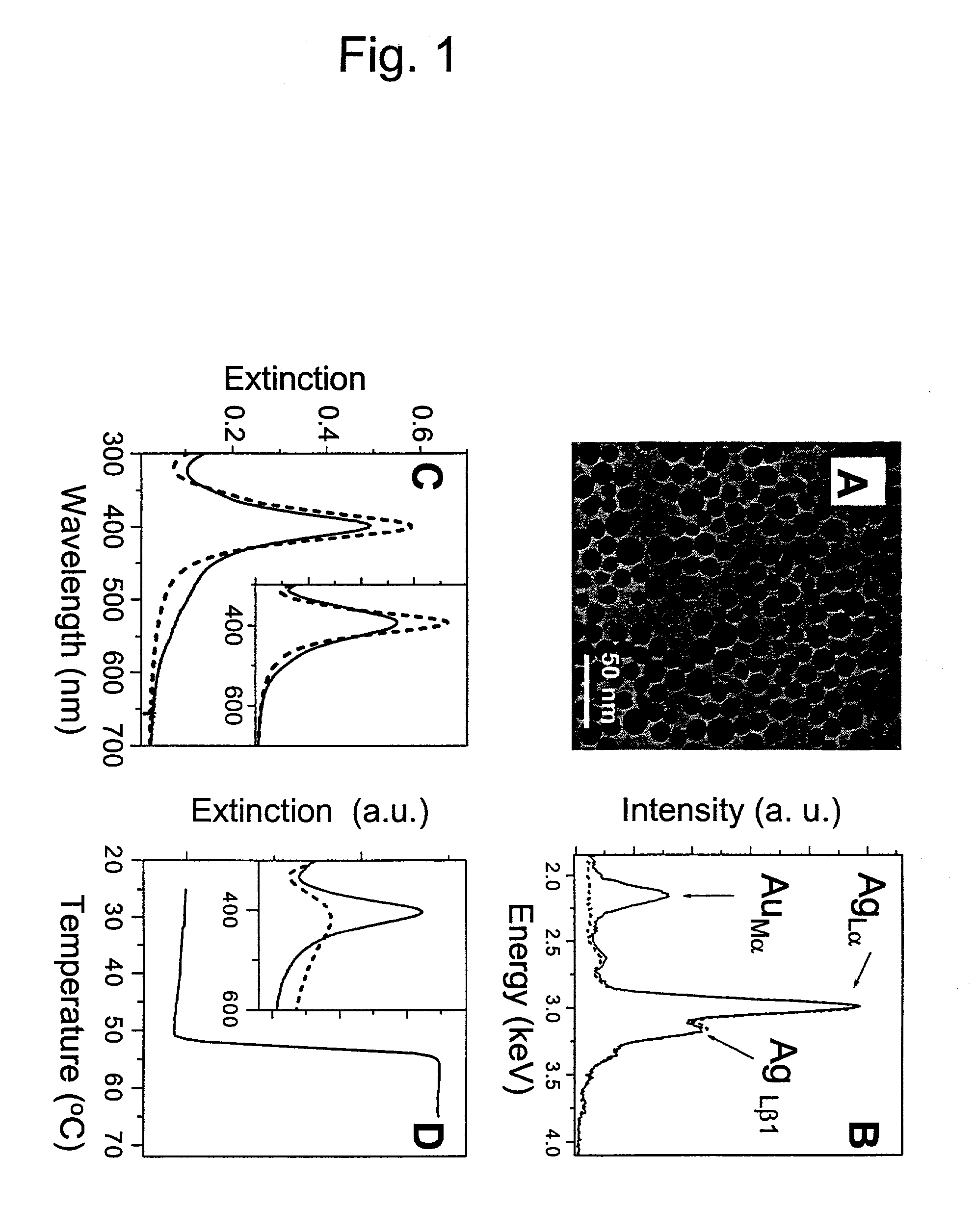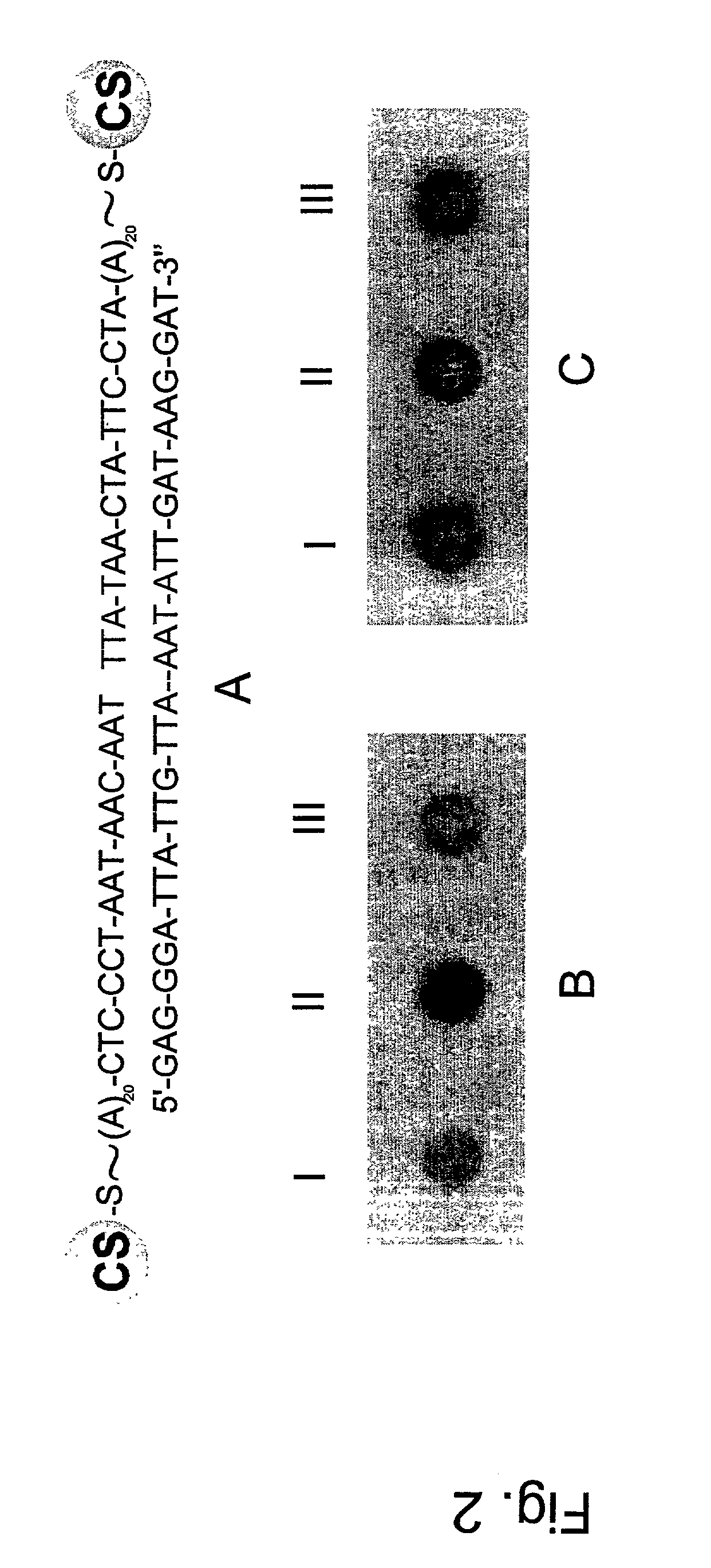Non-alloying core shell nanoparticles
a core shell and nanoparticle technology, applied in the direction of magnetic materials, powder delivery, iron oxide/hydroxides, etc., can solve the problems of limited success, cdse and cds quantum dots are more difficult to modify, and the approach is extensively utilized
- Summary
- Abstract
- Description
- Claims
- Application Information
AI Technical Summary
Problems solved by technology
Method used
Image
Examples
example 2
Preparation of Silver / Gold Core / Shell Nanoparticle-Oligonucleotide Conjugates
[0060] This Example describes the preparation of silver / gold core / shell nanoparticle oligonucleotide conjugates as probes for detecting a target nucleic acid. Two methods were employed and the resulting probes were then compared for stability. The oligonucleotide sequences used in making the conjugates are shown in FIG. 2a. These sequences were synthesized using standard phosphoramidite chemistry according to the literature. (James J. Storhoff, Robert Elghanian, Robert C. Mucic, Chad A. Mirkin, and Robert L. Letsinger, J. Am. Chem. Soc., 1998, 120, 1959).
[0061] (a) Preparation of Core / Shell Nanoparticle Conjugates
[0062] Method No. 1: Nanoparticle probes with appropriate probe oligonucleotides were prepared by derivatizing 10 mL of aqueous core / shell nanoparticle colloid (from method no. 1) with 8.about.10 OD (in about 500 uL) of alkanethiol-oligonucleotide (final oligonucleotide concentration is about 2 .mu...
example 3
Comparison of Silver, Silver / Gold Core / Shell and Silver / Gold Alloy Nanoparticle Oligonucleotide Conjugates
[0072] In this Example, the silver / gold core / shell nanoparticles prepared as described in Example 1 (method no. 1) were compared to gold nanoparticles.sup.2 and to silver / gold alloy nanoparticles.
[0073] The silver / gold alloy nanoparticles were prepared by the method of Wang, Z. L.; El-Sayed, M. A. J. Phys. Chem.B 1999, 103, 3529. Following literature procedure, 0.8 mg of HAuCl.sub.4.3H.sub.2O and 1.8 mg of silverNO.sub.3 were dissolved in 95 ml of nanopure water. The solution was heated to reflux, and 5 ml of 1% sodium citrate was added to the solution. After refluxing an additional 30 min., the solution was allowed to cool to room temperature.
[0074] The UV-Vis spectrum of the alloy particles exhibits a surface plasmon band at 428 nm with a full width at half-maximum (FWHM) of 90 nm (0.62 eV). In contrast, the UV-Vis spectrum of the silver / gold core / shell nanoparticle, with a co...
example 4
Preparation of Pt / Gold Core / Shell Nanoparticles
[0077] This Example describes the preparation of Pt / gold core / shell nanoparticles by the inventive process. In Part A, Pt core nanoparticles were prepared by hydrogen reduction of K.sub.2PtCl.sub.4 in an overnight reaction. In Part B, goldshells were grown on the Pt cores.
[0078] (a) Preparation of Pt Core Nanoparticles
[0079] In a 500-ml three-neck flask, K.sub.2PtCl.sub.4 (8.3 mg) and sodium polyacrylate (20 mg) were dissolved in 200 ml of Nanopure water. H.sub.2 was bubbled into the reaction solution overnight with stirring. This resulted in Pt nanoparticles that were purified and isolated, yielding nanoparticles of about 12 nm in diameter.
[0080] (b) Preparation of Pt / Gold Core / Shell Nanoparticles
[0081] 100 ml of 12-nm Pt nanoparticle solution (as prepared according to the above procedure) was put into a 250-ml three-neck flask. To the nanoparticle solution were added HAuCl.sub.4 and NaBH.sub.4 dropwise, simultaneously, at 0.degree. C....
PUM
| Property | Measurement | Unit |
|---|---|---|
| thickness | aaaaa | aaaaa |
| Tm | aaaaa | aaaaa |
| temperature | aaaaa | aaaaa |
Abstract
Description
Claims
Application Information
 Login to View More
Login to View More - R&D
- Intellectual Property
- Life Sciences
- Materials
- Tech Scout
- Unparalleled Data Quality
- Higher Quality Content
- 60% Fewer Hallucinations
Browse by: Latest US Patents, China's latest patents, Technical Efficacy Thesaurus, Application Domain, Technology Topic, Popular Technical Reports.
© 2025 PatSnap. All rights reserved.Legal|Privacy policy|Modern Slavery Act Transparency Statement|Sitemap|About US| Contact US: help@patsnap.com



